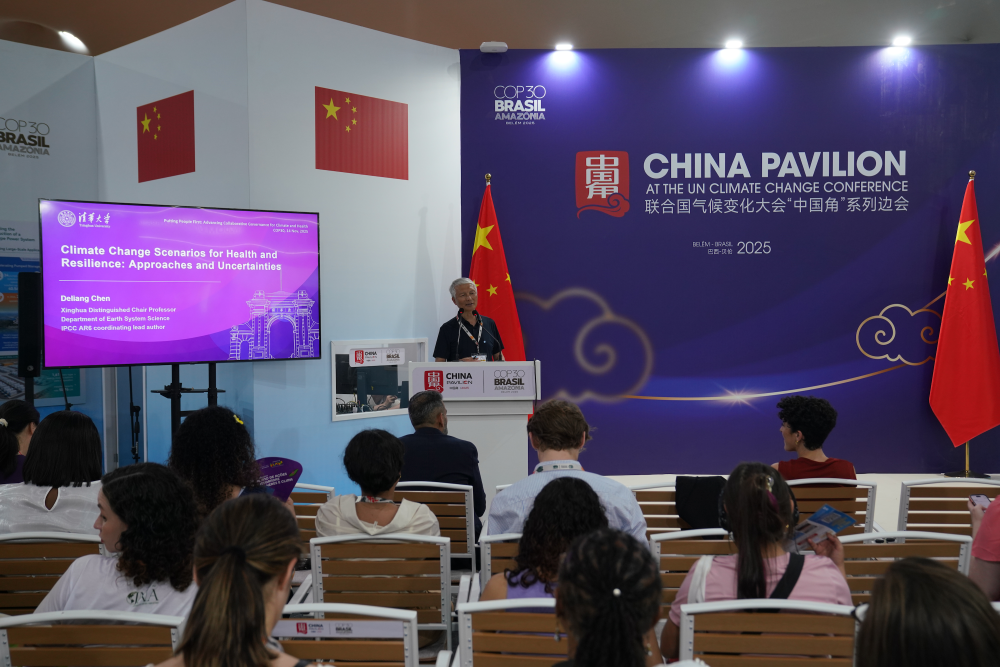Tsinghua University called on governments and all sectors of society at the COP30 stage to join forces in integrating youth-driven innovation, scientific insight, and policy action, in order to advance the deep integration of climate governance and health protection and to build a healthy, equitable, and climate-resilient world.
BELEM, 14 November 2025 —
With a strong focus on high-level dialogue, cross-sector integration, and youth innovation, the China Pavilion at COP30 successfully held its first thematic side event on “Climate and Health” titled “Putting People First: Advancing Synergistic Governance for Climate and Health.” This event marks a step forward in advancing the climate change and health agenda — from building scientific consensus to driving global action.
As the inaugural climate–health session at the China Pavilion, the event established a high-level, interdisciplinary platform for exchange and collaboration. Li Gao, vice minister of the Ministry of Ecology and Environment of China, emphasized China’s strong commitment to addressing climate-related health risks and commended the Lancet Countdown China Report led by Tsinghua University’s Department of Earth System Science and the Lancet Countdown Asia Centre. He highlighted the report’s role in improving understanding of risk patterns and supporting evidence-based policy responses.

Alexandre Padilha, minister of Health of Brazil, reflected on the close cooperation between Brazil and China in recent years and called for placing public health at the center of global climate governance. Dr. Diarmid Campbell-Lendrum, speaking on behalf of the World Health Organization (WHO) headquarters, reaffirmed WHO’s continued support for countries tackling air pollution and climate change, and highlighted the Belém Action Plan for Health and Climate as a milestone in global synergistic climate–health action.
During the youth innovation segment, Xiong Shaoyuan, Deputy Administrator of the China Meteorological Administration, underscored the urgency of addressing the climate and health crisis. He praised the youth-led project demonstrations for their deep insights into real-world problems and innovative use of emerging technologies, and reaffirmed the Administration’s commitment to supporting future Youth Innovation Challenges.
Key Highlights of the Side Event
• Launch of the 2025 China Lancet Countdown Report on Health and Climate Change.
The report provides a systematic assessment of climate–health indicators across Chinese cities and demonstrates a localized pathways for urban-level climate–health solutions that can serve as a reference for countries and regions worldwide.
• Cross-sector consensus on strengthening climate–health governance.
Experts from the Asian Infrastructure Investment Bank (AIIB), the South Australia Department for Health, Global Climate and Health Alliance, and the Institute for Climate Change and Sustainable Development at Tsinghua University jointly emphasized the need to break institutional silos, integrate policy, technology, and financing resources, and build a more inclusive and resilient future for global health.
• Finals of the “Asian Youth Climate and Health Innovation Challenge.”
Youth-led solutions showcased outstanding creativity that combined technological innovation with human-centered design. Proposals included:
Shared mobile cooling devices for urban delivery workers to prevent heat stress
Intelligent real-time mosquito surveillance to enhance dengue fever early warnings
Climate-adaptive safe navigation systems for vulnerable groups during extreme weather
A biomimetic backpack that generates drinking water from air for nomadic communities
Hyper-local digital twin systems for precision forecasting of flood and dengue risks
• Art and technology brought into climate communication.
Breaking from traditional formats, the event introduced artistic expression to enhance public engagement. The interactive installation “Next City · Next Second”—created by the Academy of Arts & Design at Tsinghua University—used algorithmic modeling to visualize future climate scenarios, turning abstract risks into intuitive experiences. The installation drew wide attention from delegates and signaled China’s advancement toward more refined and internationalized climate communication.
From Tsinghua’s Solutions to Global Action
This side event served as an important showcase of Tsinghua University’s leadership at COP30 and demonstrated the global shift toward climate governance that is more health-centered, inclusive, and pragmatic. The meeting called on governments and all sectors of society to join forces—leveraging youth innovation, scientific insight, and policy action—to promote deep integration between climate governance and health protection, and to build a healthy, equitable, and climate-resilient world.
Hosted by the Department of Earth System Science at Tsinghua University, the event welcomed leaders from the Ministry of Ecology and Environment of China, Ministry of Health of Brazil, WHO, Global Climate and Health Alliance, the Lancet Countdown, AIIB, the South Australia Department for Health, and other international partners. Together, they demonstrated China’s strong commitment to combining scientific knowledge with policy expertise to advance the integration of health considerations into global climate governance.
Editor: Li Han

